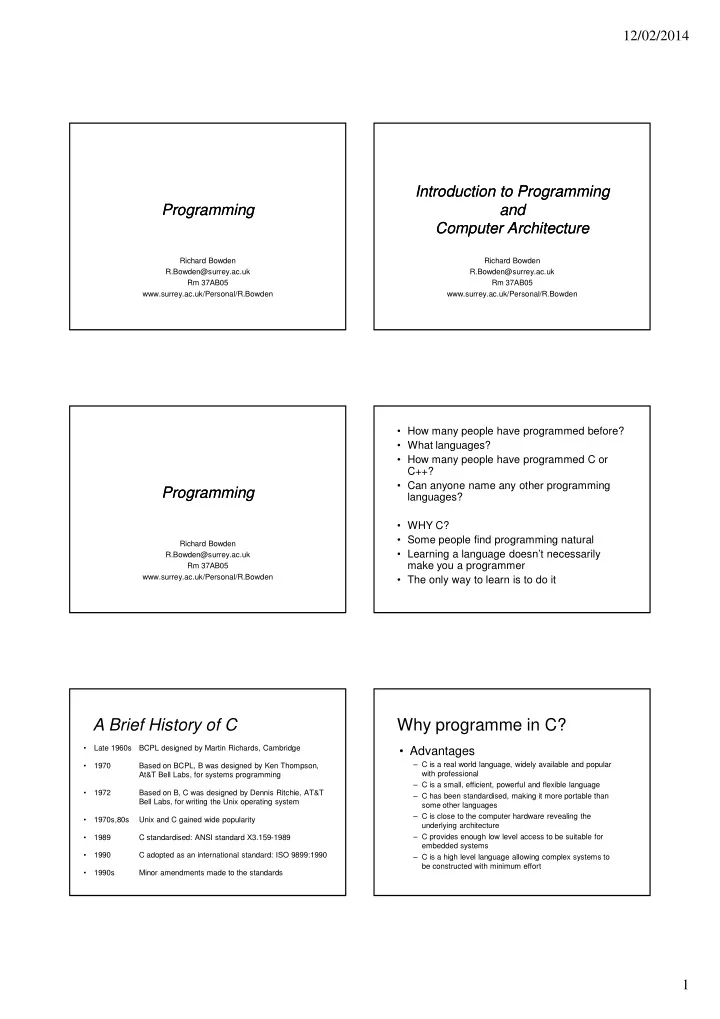

12/02/2014 Introduction to Programming Introduction to Programming Programming Programming and and Computer Architecture Computer Architecture Richard Bowden Richard Bowden R.Bowden@surrey.ac.uk R.Bowden@surrey.ac.uk Rm 37AB05 Rm 37AB05 www.surrey.ac.uk/Personal/R.Bowden www.surrey.ac.uk/Personal/R.Bowden • How many people have programmed before? • What languages? • How many people have programmed C or C++? • Can anyone name any other programming Programming Programming languages? • WHY C? • Some people find programming natural Richard Bowden • Learning a language doesn’t necessarily R.Bowden@surrey.ac.uk make you a programmer Rm 37AB05 www.surrey.ac.uk/Personal/R.Bowden • The only way to learn is to do it A Brief History of C Why programme in C? • Late 1960s BCPL designed by Martin Richards, Cambridge • Advantages – C is a real world language, widely available and popular • 1970 Based on BCPL, B was designed by Ken Thompson, with professional At&T Bell Labs, for systems programming – C is a small, efficient, powerful and flexible language • 1972 Based on B, C was designed by Dennis Ritchie, AT&T – C has been standardised, making it more portable than Bell Labs, for writing the Unix operating system some other languages – C is close to the computer hardware revealing the • 1970s,80s Unix and C gained wide popularity underlying architecture – C provides enough low level access to be suitable for • 1989 C standardised: ANSI standard X3.159-1989 embedded systems • 1990 C adopted as an international standard: ISO 9899:1990 – C is a high level language allowing complex systems to be constructed with minimum effort • 1990s Minor amendments made to the standards 1
12/02/2014 Why programme in C? Why programme in C? • Advantages • Disadvantages – C’s modular approach suits large, multi-programmer projects – C is not really a language for novices; it was designed for professional users – C’s use of libraries makes it adaptable to many different application areas – There are many things that can go wrong if you’re not careful – The Unix operating system was written in C and supports C – C lacks much of he automatic checking found in other high level languages – C gave birth to C++, widely used for applications programming and more recently Java which was based upon C++ – Small typing errors can cause unwanted effect – Many other languages borrow from C’s syntax: e.q. Java, – Does not support modern concepts such as object JavaScript, Perl etc orientation and multi-threading “C provides enough rope to hang C program - Intro.c yourself time and time again” /* Example: C program to find area of a circle */ if (x>y) if (x>z) #include <stdio.h> max=x; #define PI 3.14159 else max=z; else main() = if (y>z) max=(x>y)?((x>z)?x:z):((y>z)?y:z); { ++max%=100; max=y; float r, a; else max=z; printf(“Enter the circle’s radius: ”); scanf(“%f”,&r); max=max+1; if (max==100) max=0; a=PI*r*r; printf(“Its area is %3.2f square units.\n”,a); ≠ return; if (max==100) if (max=100) } max=0; max==0; C program - obscure.c #include <math.h> #include <sys/time.h> #include <X11/Xlib.h> #include <X11/keysym.h> double L ,o ,P ,_=dt,T,Z,D=1,d, s[999],E,h= 8,I, J,K,w[999],M,m,O ,n[999],j=33e-3,i= 1E3,r,t, u,v ,W,S= 74.5,l=221,X=7.26, a,B,A=32.2,c, F,H; int N,q, C, y,p,U; Window z; char f[52] ; GC k; main(){ Display*e= XOpenDisplay( 0); z=RootWindow(e,0); for (XSetForeground(e,k=XCreateGC (e,z,0,0),BlackPixel(e,0)) ; scanf("%lf%lf%lf",y Enter the circle’s radius: 5 +n,w+y, y+s)+1; y ++); XSelectInput(e,z= XCreateSimpleWindow(e,z,0,0,400,400, 0,0,WhitePixel(e,0) ),KeyPressMask); for(XMapWindow(e,z); ; T=sin(O)){ struct timeval G={ 0,dt*1e6} ; K= cos(j); N=1e4; M+= H*_; Z=D*K; F+=_*P; r=E*K; W=cos( O); m=K*W; H=K*T; O+=D*_*F/ K+d/K*E*_; B= sin(j); a=B*T*D- Its area is 78.54 square units. E*W; XClearWindow(e,z); t=T*E+ D*B*W; j+=d*_*D-_*F*E; P=W*E*B-T*D; for (o+=(I=D*W+E *T*B,E*d/K *B+v+B/K*F*D)*_; p<y; ){ T=p[s]+i; E=c-p[w]; D=n[p]-L; K=D*m-B*T-H*E; if(p [n]+w[ p]+p[s ]== 0|K <fabs(W=T*r-I*E +D*P) |fabs(D=t *D+Z *T-a *E)> K)N=1e4; else{ q=W/K *4E2+2e2; C= 2E2+4e2/ K *D; N-1E4&& XDrawLine(e ,z,k,N ,U,q,C); N=q; U=C; } ++p; } L+=_* (X*t +P*M+m*l); T=X*X+ l*l+M *M; XDrawString(e,z,k ,20,380,f,17); D=v/l*15; i+=(B *l-M*r -X*Z)*_; for(; XPending(e); u *=CS!=N){ XEvent z; XNextEvent(e ,&z); ++*((N=XLookupKeysym (&z.xkey,0))-IT? N-LT? UP-N?& E:& J:& u: &h); --*( DN -N? N-DT ?N== RT?&u: & W:&h:&J ); } m=15*F/l; c+=(I=M/ l,l*H +I*M+a*X)*_; H =A*r+v*X-F*l+( E=.1+X*4.9/l,t =T*m/32-I*T/24 )/S; K=F*M+( h* 1e4/l-(T+ E*5*T*E)/3e2 )/S-X*d-B*A; a=2.63 /l*d; X+=( d*l- T/S *(.19*E +a *.64+J/1e3 )-M* v +A* Z)*_; l += K *_; W=d; sprintf(f, "%5d %3d" "%7d",p =l /1.7,(C=9E3+ O*57.3)%0550,(int)i); d+=T*(.45-14/l* X-a*130-J* .14)*_/125e2+F*_*v; P=(T*(47 *I-m* 52+E*94 *D- t*.38+u*.21*E) /1e2+W* 179*v)/2312; select(p=0,0,0,0,&G); v-=( W*F-T*(.63*m-I*.086+m*E*19-D*25-.11*u )/107e2)*_; D=cos(o); E=sin(o); } } 2
12/02/2014 Course Overview Course Overview • Aims Week 1 2 3 4 5 6 7 8 E1 E2 E3 E4 9 10 11 12 • To lean the basics of computer programming and problem solving • To lean the C programming language and how this relates to the physical architecture of the computer Lectures 2x2hrs • Course Structure Labs 2x2hrs • Lectures Tutorials • Tutorials • Laboratories: exercises and assignments Assignment Lecture • Assessment Assignment x x x Due • No exam Marks 40% 20% 20% 20% • Laboratories – Worth 40% • Assignments x 3 – 2 weeks each worth 20% [1] Introduction Course Course [2] Binary Representation Resources [3] Hardware and Software Overview Overview [4] Simple Data Types [5] Standard IO [6] Operators, Expressions and Statements • Books [7] Making Decisions [8] Looping – Teach yourself C in 21 Days, 4th Edition, by Peter [9] Arrays Aitken and Bradley L Jones, SAMS. [10] Basics of Pointers Copies available in the library so you have no excuse . [11] Pointers continued [12] Strings – Any introductory book on C have a search of the library [13] Basics of Functions catalogue. [14] More functions [15] Files • Web [16] Data Structures [17] Review of Pointers – www.surrey.ac.uk/Personal/R.Bowden [18] Revision Books • Aitken, P. Jones, B., Sams Teach Yourself C in 21 Days, 0672324482, Sams. • Gookin, D. C For Dummies, 2nd Edition, 978-0-7645- 7068-1, Wiley. • McGregor, J., McGregor, R., Watt, A., Simple C, 0201403854, Addison Wesley Longman • Jackson, K., C Programming for Electronic Engineers, 0333637801, Macmillan Press • Kernighan, B.W & Ritchie, D.M., The C Programming Language, 2nd Ed., 0131103628, Prentice Hall • Knight, A. J. “Basics of MATLAB and beyond”, 1999, 0849320399 3
Recommend
More recommend